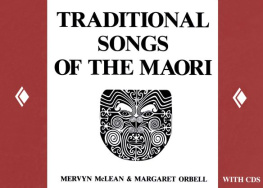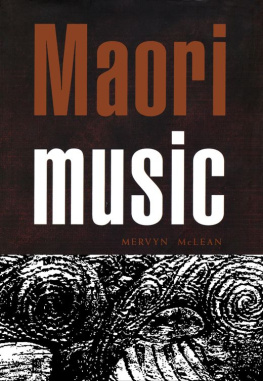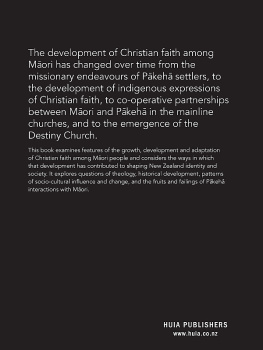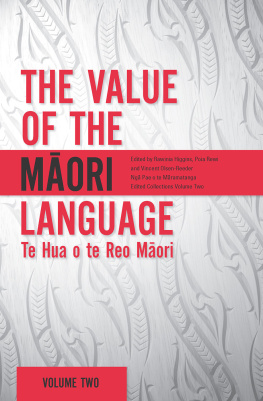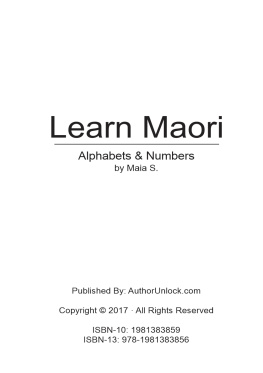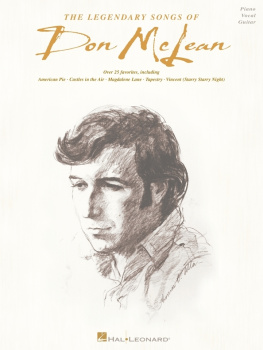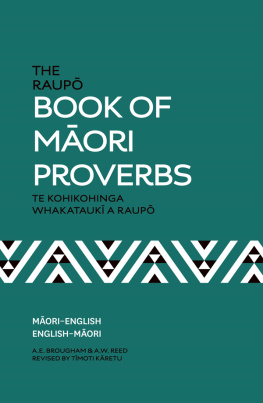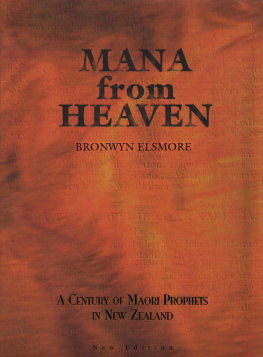Mervyn McLean - Traditional Songs of the Maori
Here you can read online Mervyn McLean - Traditional Songs of the Maori full text of the book (entire story) in english for free. Download pdf and epub, get meaning, cover and reviews about this ebook. year: 2012, publisher: Auckland University Press, genre: Children. Description of the work, (preface) as well as reviews are available. Best literature library LitArk.com created for fans of good reading and offers a wide selection of genres:
Romance novel
Science fiction
Adventure
Detective
Science
History
Home and family
Prose
Art
Politics
Computer
Non-fiction
Religion
Business
Children
Humor
Choose a favorite category and find really read worthwhile books. Enjoy immersion in the world of imagination, feel the emotions of the characters or learn something new for yourself, make an fascinating discovery.
- Book:Traditional Songs of the Maori
- Author:
- Publisher:Auckland University Press
- Genre:
- Year:2012
- Rating:4 / 5
- Favourites:Add to favourites
- Your mark:
- 80
- 1
- 2
- 3
- 4
- 5
Traditional Songs of the Maori: summary, description and annotation
We offer to read an annotation, description, summary or preface (depends on what the author of the book "Traditional Songs of the Maori" wrote himself). If you haven't found the necessary information about the book — write in the comments, we will try to find it.
Traditional Songs of the Maori — read online for free the complete book (whole text) full work
Below is the text of the book, divided by pages. System saving the place of the last page read, allows you to conveniently read the book "Traditional Songs of the Maori" online for free, without having to search again every time where you left off. Put a bookmark, and you can go to the page where you finished reading at any time.
Font size:
Interval:
Bookmark:
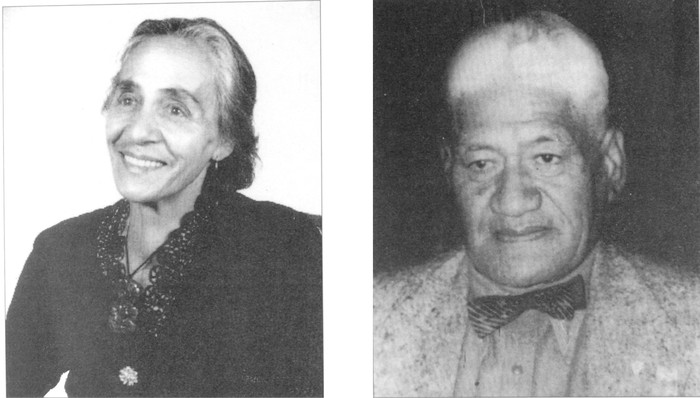
In affectionate memory of Turau Te Tomo (18961965) and Marata Te Tomo (19001982) many of whose songs are included in this book
During the 25 years since first publication of TraditionalSongsoftheMaori, both it and the recordings of the songs in it have been regularly used by Maori groups and individuals as aids for learning the songs. The authors take pride in this and hope the book will continue to be useful.
A few amendments have been made to the translations and song notes but otherwise the book has been left largely unchanged. Changes to bring the book into conformity with modern publishing conventions have not been thought necessary. To avoid the expense of recasting the transcriptions, double vowels have been retained for Maori long vowels rather than the now more usual macrons; and, in accordance with common practice among Maori people themselves, long vowels have been left unmarked in place and personal names, except in some of the song texts.
A major change in the present edition is a decision to publish it in association with CDs of the songs contained in it. When the book was first published there were widespread Maori concerns about commercialisation, which prevented publication of the recordings. These concerns have now largely evaporated and there is demand for recordings from the current generation of Maori people, which we have decided to heed. All of the recordings are from the McLean Collection, Archive of Maori and Pacific Music, University of Auckland, and royalties from sale of the recordings have been assigned to the Archive to assist its work on behalf of the Maori people.
PART I
Contents for CD included in hard copy version
T RADITIONAL Maori chant as opposed to the modern acculturated style known as Action Song is still performed today much as it was when Europeans first visited New Zealand over two centuries ago. The style is in many ways similar to indigenous musics elsewhere in Polynesia, and in most respects is altogether different from European singing.
The lack of European influence on the music is not extraordinary, since it is known that dissimilar styles are unlikely to affect one another very much, except insofar as one may displace the other. In New Zealand, traditional chant has not been replaced by the Europeanised Action Song, but is practised side by side with it. Nevertheless, justifiable fears have been expressed that traditional chant will inevitably die out. Very few waiata, songs, are now composed, capable singers are becoming fewer, and the chant repertoire seems to be shrinking1. In many communities the Kamate chant (not in this book) and Tooiamaitewaka (Song in this collection) are now the only haka commonly performed and Epaatoohau (Song 14) is the only waiata. However, there are countervailing influences, and it is even possible that there will be a reversal of the present trend. Individuals throughout the country are learning waiata from their elders and from tape recordings; there is interest in secondary schools, youth clubs, teachers colleges and universities; and at the grass roots level, waiata schools meet regularly during the winter months in several parts of the country.
There are at least three reasons for such interest First, the classical waiata may sometimes be valued out of antiquarian sentiment, or perhaps because as treasures from the past, like fine cloaks or greenstone they are rare and beautiful. More importantly, however, they continue to serve specific social and ceremonial needs. On the marae it is still customary for a speaker to precede his speech with a suitable tau marae, recitation before speaking, and to be accepted as an orator he must not only follow his speech with a waiata but also demonstrate an ability to make apt use of chant quotations during his speech. Thus it becomes worthwhile for aspiring young leaders to learn at least one or two waiata so that they will acquit themselves well on the marae.
Finally, traditional Maori chants have long been recognised, together with marae custom, the decorative arts, proverbial sayings and the Maori language itself, as a component of Maoritanga or Maoriness. As such, they are an integral part of Maori culture and an expression of the values that help maintain Maori cultural identity. So long as this remains true they will retain their place in Maoridom.
Although the texts of Maori songs have been published in many collections notably those of Grey, Shortland, Taylor, McGregor, and Ngata and Te Hurinui until now there has been no collection of both texts and music. Sir Apirana Ngata himself recognised this as a deficiency when he stated in the preface to Part 1 of NgaMoteatea (1959:xvii) that there could be no proper rendering of Maori songs without capturing the air.
One object of this book, therefore, has been to redress a balance to turn attention away from exclusive preoccupation with words, and to make the point that here can be found not poetry, not music, but songs which are an intimate blending of both. Again and again during the preparation of the book it has been brought home to the authors that neither the song texts nor the music can be fully understood in isolation. Sometimes obscurities in the musical structure of a song became suddenly clear when reference was made to the sense units of the texts. And, conversely, difficulties in the text were often resolved by reference to the music.
That the texts of traditional chants are often very beautiful and worthy of study has been recognised for many years. But this attitude has seldom been applied to the music. Elsdon Best, that seemingly least ethnocentric of men, said: The English ear detects nothing to admire in this mode of singing, and we condemn it as monotonous and tuneless (Best 1925:106). Early travellers, missionaries and settlers thought likewise and so regrettably do many New Zealanders today. Such judgements, natural though they may be, spring entirely from unfamiliarity. The indigenous Maori music system is simply different from the Western one, and is in no way inferior to it. We are used to diatonic scales, major and minor modality, wide ranges, harmony and polyphony, divisive metres and a host of melodic patterns and familiar turns of phrase that enable us to listen responsively to styles as diverse as Bach partitas, bebop, Swiss mountain songs or sung commercials. But this is of no help in understanding a different system whose scales are not always diatonic, whose modalities are not necessarily major or minor, and which has the added disabilities to Western ears of small ranges, few notes, no harmony, additive or non-existent metres and unfamiliar melodic conventions. Music, whoever may have said otherwise, is not a universal language. This does not mean, however, that Maori chant is completely inaccessible to anyone who has not been nurtured upon it or who lacks the specialised skills for reading a transcription. Even to the non-musician, the most casual glance at any of the transcriptions will make it clear that Maori chants are highly structured musically and that the music system underlying them is a sophisticated one. Some of the characteristics of this music system are outlined in Chapter 1 and it is hoped that the transcriptions themselves will be useful for students who want to study the musical structure of particular songs.
Individual analyses could have been provided for each song, but it was felt that these would serve no useful purpose since they would needlessly repeat the same general characteristics; accordingly they have been omitted. It should be pointed out that the book does not set out to deal with all aspects of Maori music. Such exhaustive treatment will be left to a later book. The present book aims merely to provide words and music for representative songs of the most common genres, together with enough information about their purposes, historical background, performance characteristics and textual and musical form to make them intelligible to the interested layman.
Font size:
Interval:
Bookmark:
Similar books «Traditional Songs of the Maori»
Look at similar books to Traditional Songs of the Maori. We have selected literature similar in name and meaning in the hope of providing readers with more options to find new, interesting, not yet read works.
Discussion, reviews of the book Traditional Songs of the Maori and just readers' own opinions. Leave your comments, write what you think about the work, its meaning or the main characters. Specify what exactly you liked and what you didn't like, and why you think so.

